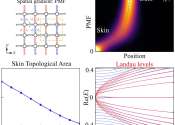Scientists reveal first data from Euclid telescope, offering snapshot of cosmic history
Scientists have released the first set of scientific data captured with the Euclid telescope, showing an exciting glimpse of the universe's distant past.

Scientists have released the first set of scientific data captured with the Euclid telescope, showing an exciting glimpse of the universe's distant past.
Astronomy
May 23, 2024
2
192

Deposits of designated critical minerals needed to transition the world's energy systems away from fossil fuels may, ironically enough, be co-located with coal deposits that have been mined to produce the fossil fuel most ...
Earth Sciences
May 20, 2024
0
55

Few things in nature are as predictable as ocean tides. Driven by the moon's and sun's gravitational pull, these persistent, short-period, and large-magnitude phenomena are apparent in nearly all types of oceanographic and ...
Earth Sciences
May 20, 2024
0
702

Two-dimensional materials such as graphene promise to form the basis of incredibly small and fast technologies, but this requires a detailed understanding of their electronic properties. New research demonstrates that fast ...
Nanomaterials
May 17, 2024
0
147

A mighty river is flowing out of the Amazon rainforest, and it's not the one you're thinking of. In the first kilometer above the forest canopy, a "flying river" is transporting moisture evaporated from Amazonian trees southwards ...
Environment
May 19, 2024
0
31

As humanity grapples with the fight against climate change, reducing greenhouse gas emissions is urgently necessary. One way to achieve this is through the carbon offset market, where organizations or individuals can buy ...
Environment
May 20, 2024
0
1

Engineers have modeled a new way to recycle polystyrene that could become the first viable way of making the material reusable. The chemical method identified to tackle hard-to-recycle packaging material, cutting landfill ...
Polymers
May 22, 2024
0
84

Due to the presence of non-Hermitian components, wave intensities tend to localize at the system boundary, namely the non-Hermitian skin effect. The skin behavior is protected by topology, making it insensitive to minor changes. ...
Condensed Matter
May 17, 2024
0
29

Plants have special corrective molecules at their disposal that can make retrospective modifications to copies of genes. However, it would appear that these "Tipp-Ex proteins" do not have permission to work in all areas of ...
Plants & Animals
May 17, 2024
0
22

Chicken breast jerky (CBJ) is a popular pet food due to its high crude protein content and long shelf life. In the production of CBJ, the drying process is a crucial step. However, the physicochemical and functional properties ...
Biotechnology
May 20, 2024
0
2
In physics, energy (from the Greek ἐνέργεια - energeia, "activity, operation", from ἐνεργός - energos, "active, working") is a scalar physical quantity that describes the amount of work that can be performed by a force, an attribute of objects and systems that is subject to a conservation law. Different forms of energy include kinetic, potential, thermal, gravitational, sound, light, elastic, and electromagnetic energy. The forms of energy are often named after a related force.
Any form of energy can be transformed into another form, but the total energy always remains the same. This principle, the conservation of energy, was first postulated in the early 19th century, and applies to any isolated system. According to Noether's theorem, the conservation of energy is a consequence of the fact that the laws of physics do not change over time.
Although the total energy of a system does not change with time, its value may depend on the frame of reference. For example, a seated passenger in a moving airplane has zero kinetic energy relative to the airplane, but non-zero kinetic energy relative to the Earth.
This text uses material from Wikipedia, licensed under CC BY-SA